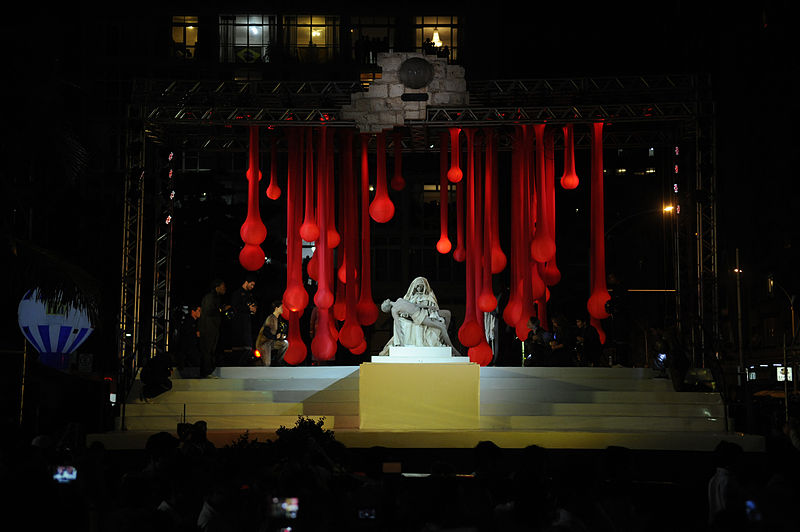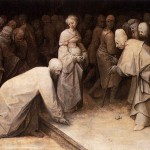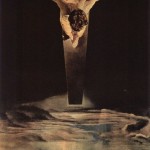Today is the feast of the Annunciation, so even though I’ve already written today I thought I’d write up a few quick thoughts.
Mary as perfect disciple and icon of faith. Among many other things, Mary stands in the Gospel as the image of the perfect disciple, and the Annunciation shows this almost as clearly as anything (her presence at the foot of the Cross being the other). When we think of this, we typically think of her fiat, but there is a much more subtle, and beautiful dynamic going on in Mary’s interaction with the angel.
For Mary is at first incredulous at the angel’s petition. She asks a perfectly reasonable–thoroughly practical, not theological–question: “How can I bear this child, since I have had no relations with a man?” This shows as clearly as possible, through Mary “full of grace”, that true faith is never blind assent. True faith is not divorced from questioning–rather, it is strengthened by questioning. True faith is the opposite of a slavish, unthinking, unreflective adhesion. (Indeed, we can see that true faith is liberation, if we connect, as we should, the Annunciation to the Visitation, and to the Magnificat: “He puts forth his arm in strength / and scatters the proud-hearted. /He casts the mighty from their thrones / and raises the lowly.”)
As faith is questioning, we also see through Mary that it is a leap. Can we think that her fiat was “fully informed”, that she perfectly knew of the Cross that her Son would carry, and the sword that would pierce her heart? We can believe that on some level, she did. She certainly had to know that the fate of the Jewish prophets was often a vale of tears. (She also had to know, and we too often forget this, that her unmarried pregnancy would make her a social outcast.) Yet in the Finding in the Temple, Luke tells us that Jesus’ parents “did not understand” what He meant when He referred to God as His Father. So we can believe that, even though Mary definitely grasped that her fiat would have momentous consequences (an understatement if there ever was one) and involve tribulation, she still did not fully understand the Christ-event, or the Cross. Faith does not wait to have all the answers neatly wrapped up in a bow. Faith is a movement of the heart, a roll of the dice, an enrollment into a great adventure. Mary doesn’t need to have all the answers before she commits–literally–her life to God.
We see this in marriage. When you get married, you never have all the answers. Your spouse could get hit by a truck the day after your wedding, become severly handicapped, and you have to spend the rest of their life caring for them. Your spouse could end up infertile, dashing your lifelong dreams of children. Your spouse could cheat, or gamble away your life savings. And yet you still have to stick by them. It’s obviously folly to marry someone you don’t know, but it is equally insane (and yet this is what our current society asks) to wait until you have all the answers to marry someone.
We also see through Mary that faith is freedom. In this moment where she says she is the Lord’s handmaid, she is perfectly free. As free as anybody except Christ on the Cross. As said, Mary understood that her choice of the fiat would have negative consequences for her, although she probably did not understand the full ramifications. She could have said no. We have to believe this. She could have said no. She could have said no, and it would have been the total end of salvation history, with no Cross, no Resurrection, no life to come. Creation would have continued galloping into absurdity towards, probably, ultimate dissolution. This is why Mary rightly receives the most esteemed title of Mother of God. Her fiat had to cost Mary, and she could have said no. But if she had said no, it would have been out of fear. Fear of social opprobrium (and who among us has none?), fear of tribulation, fear of the unknown, the totally Unknown, blasting into her life like a torrent and changing everything. Who would not have that fear! We shouldn’t romanticize the Annunciation, we shouldn’t believe that it was easy-peasy; Mary may have been Immaculate, but Jesus sweated blood at Gethsemane. When Luke tells us that she was “greatly troubled”, we have to see it for the tactful understatement that it is. And yet at that moment, Mary is perfectly free, and her perfect freedom caused the salvation of all humanity.
Mary, Ark of the Covenant. The reading of the Annunciation is from Luke, and Luke’s theology is a theology of the Covenant and the Temple. The Annunciation makes it explicit: “Hail Mary, full of grace.” What is “full of grace”? Why, it’s the holy of holies, the Ark of the Covenant–the dwelling place of God among his people.
In his book Daughter Zion, Joseph Ratzinger points out that the archetypal “female” in the Old Testament is Israel herself–God’s bride. This is a recurring theme. Israel’s unfaithfulness is described as adultery and prostitution, and God as her faithful lover. And in this womanly metaphor, Israel is described as both virgin and mother. Where does Catholic Mariology comes from? From here, Ratzinger answers. Mary is the link–the matrix–between the Old and the New Testaments. Mary is the new Ark of the Covenant, the new Israel, the incarnation of the Church. She is the past and the future, and the link between them–literally, as the Jewish woman who gave birth to the Savior of all. The Luccan Temple theology of the Annunciation makes all this very clear.













